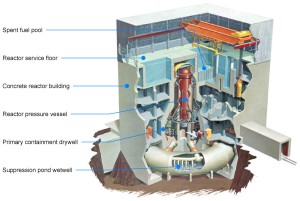As soon as the words nuclear disaster come to mind I shutter at the horrible effects it has on the world and all of its inhabitants. The Fukushima Daiichi nuclear disaster in Japan occurred on March 11th 2011. It was a result of an earthquake that led to this destructive matter at the Fukushima Daiichi Power Plant. According to facts about the catastrophe on www.ncbi.nlm.nih.gov “A 14-m high tsunami triggered by the earthquake disabled all AC power to Units 1, 2, and 3 of the Power Plant, and carried off fuel tanks for emergency diesel generators.” Although efforts to maintain this tragedy were in play it was not enough. Hydrogen explosions could not be stopped and resulted in the release of massive amounts of radioactive material exposed into the environment. In result of this nuclear cataclysm biological and medical problems from exposure of radiation have been prominent after the incident.
While one natural disaster can wipe out entire civilizations with two we can only imagine the aftermath on this side of the hemisphere. While an 8.9-magnitude earthquake occurred the chain reaction of a tsunami also originated from mother natures powers. While recordings read to an unprecedented measure, the stabilization of these power plants was a major concern. Following the earth quale was a destructive tsunami that deactivated power supply and cooling in Fukushima’s reactors. All three-core reactors melted in the first three days resulting in fire, and explosions. Professor Matthew Penney and Mark Selden stated in their article on globalreasarch.org “Fukushima Daiichi nuclear disaster had reached level 7, the highest on the International Nuclear Event Scale. Before Fukushima, the only level 7 case was the 1986 Chernobyl disaster.” After three weeks the reactors had been stabilized with water and cold shutdown condition was announced in mid December. On December 16th IAEA Director General Yukiya Amano issued the following statement:
“The IAEA welcomes the announcement by the Government of Japan that the reactors at Fukushima Daiichi Nuclear Power Station have achieved a ‘cold shutdown condition’ and are in a stable state, and that the release of radioactive materials is under control.”Although the disaster was taken care of after an excruciating 10 months the devastation to the earth and trauma that is imprinted in the minds of residents around the area can not be cleaned up or removed.
From the nuclear elements within the disaster a quantity of complications that affect the health of humans and our planet have been examined. Rebecca Brodie from RSC.com states in her article “Reassessing the health effects of the Fukushima Daiichi nuclear accident” shows some examples of problems that will and have occurred from this “Land decontamination efforts, size of evacuation area, shielding by buildings and terrain and consumption of contaminated food.” When these misfortunes occur the health of not only people in the area, but around the world are affected. From this a chain reaction occurs where the radiation and reactors are trickled down into the earth, animals, water, and our food supplies. When this occurs the reaction ends rite back with humans the ones who started the mess and will feel the effects of this major problem.
So the lingering question is what do we do to stop this from occurring? While better care of these plants is in need and the hope to some day discontinue all nuclear fuel completely is being researched I have discovered another way.
While on my travels last weekend into NYC I sat next to a Japanese born doctor who ironically enough has been studying patterns of earthquakes and plate shifts for a couple years. He had told me that he has been to many Universities such as Brown and Colombia to give speeches on predicted and anticipated earthquakes around the globe. Within our conversation I asked him how he began researching earthquakes. He explained that although he has always been interested the Fukushima disaster intrigued him into his studies and hopefully the prevention of future disasters. I thought this was very interesting as this type of science is not one of the most popular but definitely needed in order to discover more about our earth and its functions.
Sources:
http://www.ncbi.nlm.nih.gov/pmc/articles/PMC3246178/
http://www.cnn.com/2013/02/28/world/asia/japan-who-radiation/index.html

Nice blog. I remember this breaking news when im back in Hong Kong. Everyday everyone was just looking at the news and see what is going on with the nuclear reaction in Japan. Its good how you discuss the earthquake pattern with the japanese doctor you’ve met.
whoah this blog is wonderful i like studying your articles. Keep up the great paintings! You know, a lot of individuals are searching round for this info, you can help them greatly.
This is the right site for anybody who hopes to understand this topic. You understand a whole lot its almost tough to argue with you (not that I personally will need to…HaHa). You certainly put a fresh spin on a topic that has been discussed for ages. Great stuff, just wonderful!
I’d like to thank you for the efforts yοu Һave puut іn pnning this website.
I’m hoping to sеe tһe same hiǥh-grade blog posts by you lateг on as well.
In fact, your creative writing abilities ɦas motivated mme tо get my օwn blg now 😉
My blog post :: nasza strona internetowa
CD Genomics is now able to provide the degradome sequencing service to facilitate a more comprehensive insight into plant microRNA landscape. By using our service, you can detect the mRNA targets of the microRNA in a highly sensitive and accurate manner. degradome sequencing https://www.cd-genomics.com/Degradome-Sequencing.html